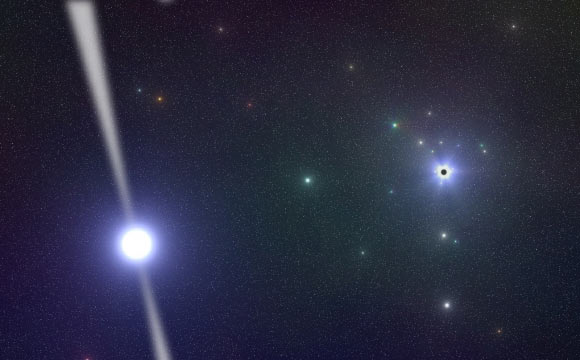An international team of astronomers has used observations of the newly discovered pulsar PSR J1745-2900 to measure the magnetic field emanating from a swirling disk of material surrounding the supermassive black hole at the center of our Milky Way Galaxy.
The Milky Way Galaxy harbors a supermassive black hole at its center, some 26,000 light-years from Earth.
The black hole is about 4 million times more massive than the Sun. Black holes, concentrations of mass so dense that not even light can escape them, can pull in material from their surroundings. That material usually forms a swirling disk around the black hole, with material falling from the outer portion of the disk inward until it is sucked into the black hole itself. Such disks concentrate not only the matter pulled into them but also the magnetic fields associated with that matter, forming a giant, twisting magnetic field that is thought to propel some of the matter back outward along its poles in superfast jets.
The region near the black hole is obscured from visible-light observations by gas and dust, and is an exotic, extreme environment still little-understood by scientists. The magnetic field in the central portion of the region is an important component that affects other phenomena.
The first link to measuring the magnetic field near the black hole came April, 2013 when NASA’s Swift satellite detected a flare of X-rays from near the Milky Way’s center.
Scientists soon determined that the X-rays were coming in regular pulses. Follow-on observations with radio telescopes showed the object PSR J1745-2900 is a magnetar, a highly-magnetized pulsar, or spinning neutron star.
The pulsar PSR J1745-2900 is the closest yet found to the black hole, possibly within less than half a light-year. Analysis of the radio waves coming from it showed that they are undergoing a dramatic twist as they travel from the pulsar to Earth. Such a twist, called Faraday rotation, comes when the waves travel through charged gas that is within a magnetic field.
The charged gas is somewhere roughly 150 light-years from the black hole, directly between the pulsar and Earth. Measuring the twist in the waves caused by their passage through this gas allowed the scientists to calculate the strength of the magnetic field. The magnetic field is a crucial part of the black hole’s environment, affecting the structure of the flow of material into the black hole, and even regulating that flow.
The measured strength of the magnetic field at the presumed distance of the gas cloud from the black hole is about what astronomers expected, based on the intensity of X-rays and radio waves coming from the area closest to the black hole. The measurements also indicate that the field is relatively well-ordered, instead of turbulent,
“The closer you get to the black hole and the disk surrounding it, the stronger the magnetic field should become,” said Dr Paul Demorest from the National Radio Astronomy Observatory, co-author of a paper published in the journal Nature.
“Our measurement shows the field strength we would expect at the distance we believe that gas cloud is from the black hole.”
______
Bibliographic information: Eatough RP et al. A strong magnetic field around the supermassive black hole at the centre of the Galaxy. Nature, published online August 14, 2013; doi: 10.1038/nature12499








